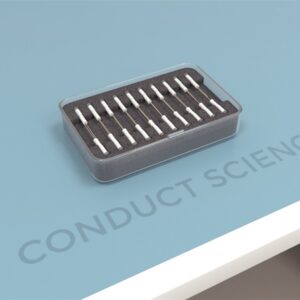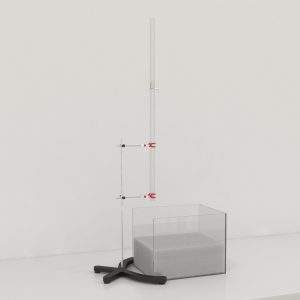$1,390.00
Bees can be trained to associate colors with a sugar reward in an environment closely resembling natural foraging conditions. This setup enables researchers to pair sucrose or other solutions with an artificial flower patch to investigate reward expectations.
The artificial flower patch comprises 24 Eppendorf tubes, each 4 cm deep, functioning as flowers and included in your order. These tubes are evenly distributed across a foraging arena, which consists of two superimposed acrylic plates. The lower plate is made of 0.7-cm thick opaque acrylic plastic, while the upper plate is 0.2-cm thick transparent Plexiglas.
The tubes are positioned within 24 holes, each 1 cm in diameter, raised 1.8 cm above the upper surface of the transparent Plexiglas plate. This setup allows bees to view 24 color signals—12 yellow and 12 blue—through the upper transparent Plexiglas plate.
The flowers are held above the upper surface of the patch, with the colored circles positioned beneath this surface. Both the flowers and their corresponding visual stimuli can be easily replaced between trials.

MazeEngineers empowers preclinical neuroscience research with meticulously designed, customizable behavioral apparatuses. From manual classic mazes to fully automated smart systems, we provide the tools scientists need to capture high-quality, reproducible data for studies on learning, memory, anxiety, and depression.


bool(false)

Features |
Foraging arena: L: 28 cm x W: 28 cm |
Two superposed acrylic plates with 24 holes of 1cm in diameter |
Upper plate: 0.2cm acrylic clear acrylic plate |
Lower plate: 0.7-cm thick grey acrylic plate |
Artificial flower patch: 4cm deep; 480 eppendorf tubes |
Color: diameter of 3.8 cm. 24 colored circles |

The Bee Reward Expectations Apparatus (BREA) is employed to investigate reward expectations in honeybees, an area where data is relatively scarce compared to vertebrates, as complex cognitive abilities were traditionally thought to be exclusive to animals with larger brains. Gil et al. developed BREA specifically to observe reward expectations in foraging honeybees under conditions that mimic their natural foraging environments.
Associative learning for rewards hinges on the connection between external cues and the internal representation of past reward experiences. Studying reward learning can enhance our understanding of behavioral changes due to rewards, expectations of rewards, goal-directed behavior, and the cognitive complexity involved in decision-making and planning (Gil, 2010).
BREA consists of an artificial flower patch set within a square foraging arena composed of two overlapping plates. Each plate features 24 holes designed to hold Eppendorf tubes (representing flowers) filled with sucrose solution as a reward for the bees. Surrounding the flowers are colored circles serving as visual stimuli, visible through the overlapping plates.
During training, experimental bees are allowed to inspect and feed on the flowers, which vary in sucrose solution volume across two variable and three constant reward trials. Subsequently, the bees are tested without the presence of sugar rewards. Researchers observe the bees to determine their ability to choose the correct flower based on visual stimuli and measure the total time spent searching for a reward.
BREA consists of an artificial flower patch set within a 28 cm × 28 cm foraging arena. This arena is constructed using two square acrylic plates stacked on top of each other, each containing 24 evenly spaced holes, each 1 cm in diameter. The upper plate is crafted from 0.2 cm thick transparent acrylic, while the lower plate is made of 0.7 cm thick opaque acrylic.
The artificial flowers are represented by Eppendorf tubes, each 4 cm deep, placed within the 24 holes of the acrylic plates. These tubes protrude 1.8 cm above the upper transparent acrylic plate. Surrounding each Eppendorf tube are 24 colored circles—12 blue and 12 yellow—with a diameter of 3.8 cm. These circles are visible through the upper transparent plate, centered around the Eppendorf tubes.
A colony of Apis mellifera carnica bees resides in a two-frame observation hive located indoors. An artificial flower patch containing unscented 50% w/w sucrose solution is positioned 145 meters away from the observation hive. A small cohort of labeled recruiting bees from the colony is allowed to visit and feed on the artificial flower patch. These recruiting bees entice nest-mates to join them in the foraging arena.
New bees arriving at the arena are trapped before they access the sucrose solution and marked with plastic tags. After tagging, these bees are cooled and released as potential experimental subjects. Bees that return to the flower patch undergo a pre-training phase to become experimental bees.
To ensure experimental integrity, the entire apparatus is meticulously cleaned to eliminate any extraneous cues that could influence the bees’ performance. Tracking and recording of trials are facilitated using advanced systems such as the Noldus EthoVision XT tracking and video system.
Load the Eppendorf tubes or flowers with 50% w/w sucrose solution. Remove the colored circles surrounding the flowers to create a uniform opaque gray background in the foraging arena. Each experimental bee is permitted two visits to the flower patch before commencing the training phase.
Recruit bees and any newly arriving individuals are captured once the pre-training phase begins and confined in small cages until the experiment concludes.
The training phase commences when the experimental bee visits the flower patch following its last or second pre-training visit. Initially, place 12 yellow and 12 blue colored circles randomly around the flowers, adjusting their positions throughout the training phase with each visit by the bee. Each experimental bee is allowed a total of nine visits to the patch.
Experimental bees are divided into two groups based on reward criteria: one group receives a 20% w/w sucrose solution reward when they reach yellow flowers, while the other group is rewarded at blue flowers.
The training phase includes five distinct series of experiments, featuring varying reward magnitudes. In the first variable series, the sucrose solution volume in the flowers increases progressively: 2 μL for visits one to three, 5 μL for visits four to six, and 10 μL for visits seven to nine. Conversely, in the second variable series, the volume decreases: 10 μL for visits one to three, 5 μL for visits four to six, and 2 μL for visits seven to nine.
The remaining three series maintain constant sucrose solution volumes across all nine visits by each experimental bee: 2 μL in the small constant series, 5.67 μL in the medium constant series, and 10 μL in the large constant series.
Replace the Eppendorf tubes with new tubes containing no sucrose solution. Remove the foraging arena from the feeding location used during the training phase. Observe the behavior of each experimental bee by allowing them to visit the patch at 24, 25 and 48 hours after the training phase.
Gil et al. utilized BREA to investigate the development of reward expectations in honeybees. Initially, they conditioned the bees using a neutral stimulus (flower color) paired with an unconditioned stimulus (sugar reward). Subsequently, the honeybees were tested in the absence of sugar reward to assess their behavior. The study revealed that honeybees exposed to increasing volumes of sugar reward during training spent more time inspecting flowers 24 and 48 hours post-training compared to those exposed to decreasing rewards. This finding marks the first documentation that honeybees form long-term expectations of reward, influencing their foraging behavior in natural settings even after extended periods without reinforcement. Such insights contribute significantly to understanding goal-directed behaviors, decision-making processes, and planning in bees.
The following data can be obtained from the experiment
Gil M, De Marco RJ, Menzel R (2007). Learning reward expectations in honeybees. Learning & Memory 14(7), 491-6. DOI: 10.1101/lm.618907
Gil M (2010). Reward expectations in honeybees. Communicative Integrative Biology 3(2), 95-100.
There are no questions yet. Be the first to ask a question about this product.